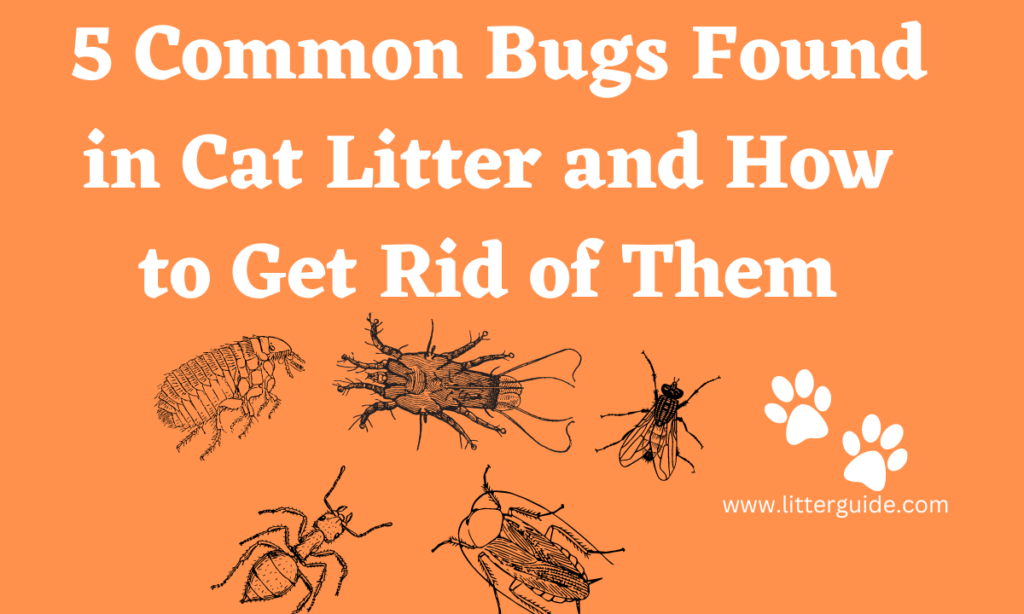Table of Contents
Introduction to 5 Common Bugs Found in Cat Litter
As a cat owner, one of the most important things you need to take care of is your cat’s litter box. It’s where they do their business, and it’s important to keep it clean and free of any bugs or harmful bacteria. In this article, we will discuss 5 common bugs found in cat litter and how to get rid of them.
Fleas
Fleas are small, wingless insects that are parasites, meaning they feed on the blood of animals. They can transmit diseases to cats and humans, such as tapeworms, Bartonella (cat scratch fever), and flea allergy dermatitis. Flea allergy dermatitis is a common skin condition that causes intense itching, hair loss, and skin irritation in cats.
Fleas are commonly found in outdoor areas, but they can also hitch a ride inside your home on your cat’s fur. Once they infest your home, they can quickly multiply and spread to other areas, including your cat’s litter box.
How To Get Rid Of Fleas
To get rid of fleas, you need to treat your cat and your home. You can use a flea comb to remove the fleas from your cat’s fur and use a flea shampoo or spot-on treatment to kill any remaining fleas. You should also vacuum your home regularly, paying special attention to your cat’s favorite areas. Make sure to wash your cat’s bedding and any other fabrics that may have come into contact with fleas.
Ants
Ants are attracted to the scent of cat urine and feces, which makes your cat’s litter box a prime target for them. While ants aren’t necessarily harmful to cats or humans, they can contaminate your cat’s litter box with dirt and bacteria.
If ants invade your cat’s litter box, they can make it difficult for your cat to use the box, which can lead to litter box aversion and inappropriate elimination behaviors.
How To Get Rid Of Ants
To get rid of ants, you need to keep your cat’s litter box clean and dry. You can also use an ant repellent around the area to deter ants from entering. If you have a severe ant infestation, you may need to contact a pest control professional.
Cockroaches
Cockroaches are nocturnal insects that are attracted to warm and humid environments, making your cat’s litter box an ideal breeding ground for them. Cockroaches can carry bacteria, viruses, and parasites, including salmonella and E.coli, which can cause food poisoning and other illnesses in cats and humans.
Cockroaches can easily infest your cat’s litter box, making it an unsanitary environment for your cat to use. If left untreated, a cockroach infestation can quickly spread to other areas of your home.
How To Get Rid Of Cockroaches
To get rid of cockroaches, you need to keep your cat’s litter box clean and dry. You should also seal any cracks or openings in your home to prevent cockroaches from entering. You can use baits or traps to kill any remaining cockroaches, but if the infestation is severe, you may need to contact a pest control professional.
Dust Mites
Dust mites are microscopic bugs that feed on dead skin cells shed by cats and humans. They thrive in warm and humid environments, such as bedding, carpets, and upholstery, but they can also infest your cat’s litter box.
While dust mites aren’t harmful to cats or humans, they can cause allergies and respiratory problems, such as asthma, in susceptible individuals. Dust mite allergy symptoms may include sneezing, runny nose, itchy eyes, and skin rash.
How To Get Rid Of Dust Mites
To get rid of dust mites, you need to wash your cat’s bedding and any other fabrics that may have come into contact with dust mites in hot water. You should also vacuum your home regularly, using a vacuum with a HEPA filter. You can also use allergen-proof covers on your cat’s bedding to prevent dust mites from entering.
Flies
Flies are attracted to the smell of cat waste and can easily infest your cat’s litter box. They can transmit diseases, such as E.coli and salmonella, to cats and humans. Flies can also contaminate food and other surfaces in your home with their feces, which can cause illness in humans.
If flies invade your cat’s litter box, they can lay eggs in the litter, leading to a maggot infestation. Maggots can cause skin irritation and infection if they come into contact with your cat’s skin.
How To Get Rid Of Flies
To get rid of flies, you need to keep your cat’s litter box clean and dry. You should also seal any openings in your home to prevent flies from entering. You can use fly traps or sticky strips to catch any remaining flies.
Preventing Bugs in Your Cat’s Litter Box
The best way to prevent bugs from infesting your cat’s litter box is to keep it clean and dry. Here are some tips to keep your cat’s litter box bug-free:
-
- Scoop the litter box daily: Removing waste from the litter box as soon as possible will prevent flies, ants, and cockroaches from being attracted to it.
-
- Change the litter frequently: Regularly changing the litter will prevent the build-up of bacteria and parasites.
-
- Use a covered litter box: A covered litter box will prevent flies and other insects from entering.
-
- Keep the litter box in a dry and well-ventilated area: A dry and well-ventilated area will prevent the growth of mold and bacteria, which can attract bugs.
-
- Use a litter box liner: A liner will make it easier to remove waste and keep the litter box clean.
Conclusion
In conclusion, bugs can easily infest your cat’s litter box, posing a potential health risk to both cats and humans. Fleas, ants, cockroaches, dust mites, and flies are the most common bugs found in cat litter boxes. To prevent these bugs from infesting your cat’s litter box, it is essential to keep it clean and dry. Regular scooping, litter changes, and using a covered litter box can help prevent bug infestations. If you do notice bugs in your cat’s litter box, it is crucial to take action quickly to prevent further infestations and potential health risks.



